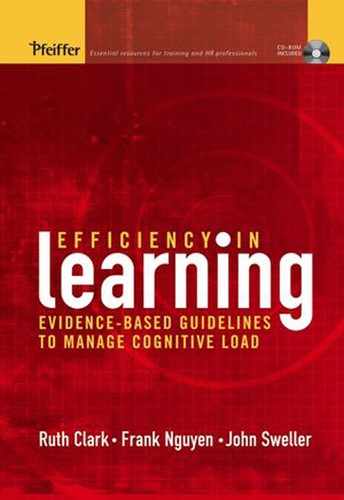IN PART V WE OFFER two quite different opportunities to integrate all of the cognitive load theory principles that we have presented throughout the book. In Chapter 12 we discuss how and when you can apply cognitive load principles in the context of your instructional decisions as a training facilitator or designer. Specifically, we consider how cognitive load theory applies to your instructional planning, development of materials, and implementation and evaluation activities. In Chapter 13 you have a different opportunity to integrate the principles in the book through a personal account by John Sweller of how cognitive load theory originated, developed, and evolved over the past twenty-five years.
Read | To Find Out How |
Chapter 12. Applying Cognitive Load Theory | What you discover during instructional planning regarding content, target audience, and delivery media will shape your application of cognitive load principles To best use visuals, audio, text, examples, and practice during development of your training To apply cognitive load guidelines during implementation of training by instructors and in training handouts To evaluate your instruction for efficiency |
Chapter 13. The Evolution of Cognitive Load Theory | Cognitive load theory originated and evolved |
Video Interview with John Sweller: Chapter Preview/Review
Chapter 12: Applying CLT. An overview of the applications of cognitive load theory
Sample Excel e-Lessons
You can see our application of cognitive load theory as a result of our analysis, design, and development decisions in our asynchronous and synchronous demonstration e-lessons:
Before: Overloaded Excel Web-Based Lesson. This asynchronous e-learning sample violates most of the guidelines for reducing extraneous cognitive load discussed in this part of the book.
After: Load-Managed Excel Web-Based Lesson. This asynchronous e-learning sample applies most of the guidelines for reducing extraneous cognitive load discussed in this part of the book.
Virtual Classroom Example. This synchronous e-learning sample applies most of the guidelines for reducing extraneous cognitive load discussed in this part of the book.
Applying Cognitive Load Theory to Instructional Planning
Your Target Audience
The Target Audience for the Excel Course
Your Content
Content for the Excel Course
Your Delivery Media
Delivery Media for the Excel Course
Training Development and Cognitive Load Theory
Start with Visuals and Performance Aids
Develop Explanations of Visuals and Performance Aids
Develop Examples and Practice for Major Tasks
Develop Supporting Knowledge Topics
Challenges Implementing Cognitive Load Theory with Many Authoring Software Packages
Violations of Redundancy
Limitations of Cueing Options
Lack of Technology for Adaptive Learning
Applying Cognitive Load Theory to Training Implementation
Instructor Implementation of Cognitive Load Techniques
Learner Support in Asynchronous Training
Training Handouts
Evaluating Courseware for Efficiency
The Bottom Line
On the CD
John Sweller Video Interview
Sample Excel e-Lessons
